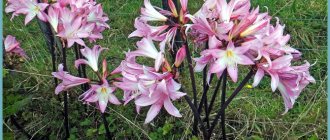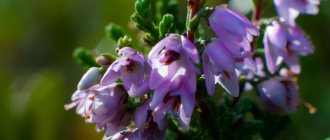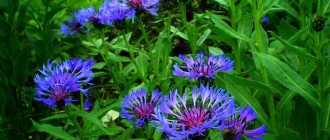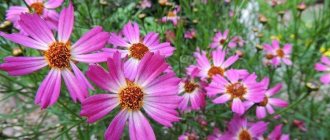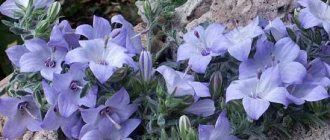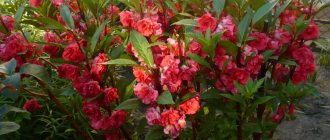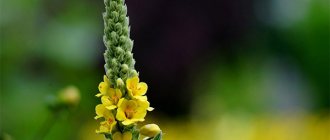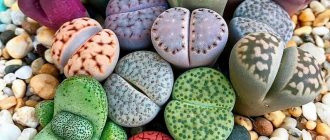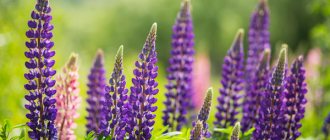This wonderful cornflower flower grows in Russia and belongs to the genus of herbs of the Compositae family. Two varieties are especially widespread: blue and meadow.
This delicate flower is always present in fields planted with grain crops - it grows not only from the edge of the field, but also between the ears of wheat and rye. According to researchers, a small number of these plants significantly contributes to improving the quality of grain harvests.
This is a biennial plant, easily propagated by self-sowing and grows up to 80 cm in height. It came to Russia along with the seeds of wheat and other grains. Cornflower leaves growing from below are different from the upper leaves. From below they are petiolate and pinnately lobed; towards the top they become linear and sessile.
Flowers are located at the top and arranged in baskets. The inflorescences in the basket, located on the edge, are sterile and have the shape of an enlarged funnel. The flowers located in the center of the basket are bisexual and form oblong-shaped gray seeds with a tail. With the help of this tail and the wind, the seeds are perfectly dispersed around the mother bush.
The flowering time of cornflower is the first half of summer. The flower is highly prolific; up to 6,000 thousand seeds grow on one bush.
Growing perennial garden cornflower
Garden cornflower perennial planting and care photo
- Prefers a place well lit by the sun, open areas, space, but easily tolerates some shading.
- Requires virtually no maintenance. Good on alpine hills, as a border plant, in flower beds.
- Unusually good when surrounded by cereals. Used for meadow-style plantings, where it is especially good in combination with white and yellow flowers.
- Excellent resistance to harsh winters. It can live for more than 10 years in one place without transplantation.
Reproduction methods and varieties
Annual and perennial cornflowers are bred in different ways: the former are planted only with seeds, while the latter are sown and grown by dividing the bush. To achieve earlier flowering, both are sown as seedlings.
Summer residents prefer perennial species that can grow in one place for up to 10 years.
Cornflower has been cultivated as a garden flower since the mid-16th century.
Plants are planted in flower beds, used in mixborders, alpine slides, and used as borders.
| Annuals | |
| Wild view | Variety |
| Cornflower blue, field or blue. (Centaurea cyanus) | f. alba plena hort. f. plena azurea f. plena rosea f. plena carminea |
| Black Ball | |
| Blue Diadem | |
| Florence Pink | |
| Musk cornflower (Centaurea moschata) or musk amberboa (Amberboa moschata) | Bride |
| Morgan |
| Perennial | |
| Wild view | Variety |
| Fisher's cornflower (Centaurea fischeri) | No cultivated varieties |
| Russian cornflower (Centaurea ruthenica). | No cultivated varieties |
| White cornflower (Centaurea dealbata or Psephellus dealbatus) | John Courts |
| Soft cornflower (Centaurea mollis) | No cultivated varieties |
| Large-headed cornflower (Centaurea macrocephala) or large-headed cornflower (Grossgeimia macrocephala). | No cultivated varieties |
| Mountain cornflower (Centaurea montana). | Parham |
| Grandiflora | |
| Alba | |
| Rosea | |
| Violetta |
Cornflower planting
It is best to plant plants in April-May. At this time, the soil warms up superbly. It does not have any special soil requirements - it can even be planted in soil with a high lime content. Both root suckers and seedlings, as well as sections of rhizomes with buds, are placed in the ground.
Maintain a distance - it should be at least 50 centimeters. This will allow the cornflower to form a lush, beautiful bush.
After planting in open ground, the soil is pressed down slightly to fill empty cavities in the ground. Thanks to this simple technique, the plants will be able to take root well. Planting and care assume that the rhizomes will grow down and to the sides, and the bud can be buried in the ground no more than 3 centimeters.
When planting cornflowers, the soil can really be any, but it is better to choose a place that is open and well lit by the sun. Partial shade is also allowed, but in this case they will grow a little worse.
Growing seedlings
In April, annuals and perennials are sown for seedlings.
To do this, prepared containers are filled with soil for flowers, moistened, seeds are planted to a depth of 1–2 cm and covered with film. The container is installed at a temperature of +20–22.
Thanks to this shelter, a greenhouse effect is created, and heat and high humidity promote rapid germination. After germination, the film is removed and the container is placed in a well-lit place.
The sprouts are fed once with complex fertilizers for seedlings. When they reach 10 cm, they are transplanted into open ground to a permanent place at a distance of 30–40 cm from each other.
Annuals grown in this way open their buds 3 weeks earlier, and perennial bushes take root well by autumn and bloom the next season.
Description and types of cornflower
Garden cornflower is a beautiful, simple flower that does not require special care. It can be annual, biennial or perennial. The colors are completely different: blue, purple, yellow, pink, white, depending on the variety.
White cornflower is listed in the European Red Book as a rare endangered species.
Field cornflower, on the contrary, is a weed. They are actively fighting him. This type of weed infests rye and is dangerous to horses.
In general, cornflower grows up to 1.2 m!
Varieties of cornflower
In nature there are a large number of different varieties of this flower. They differ primarily in the shape of the flower basket, color and stem height. Let us describe the types that are most common.
Cornflower blue
In our country it is also called the voloshka, the ragwort and the cyanosis. It grows with straight stems, the height of which is 80 cm. The flowers are blue or azure, arranged in sparse baskets, blooming from the beginning of summer until the first frost.
The gray-green leaves are rough to the touch, the lower ones have petioles, but the higher the leaves are located on the stem, the more they change their shape to that of a lily.
White
These are perennial flowers of very low stature, barely reaching 25 cm. With beautiful double flowers, they are collected in elastic baskets with a diameter of about 4 cm. This rare type of flower is included in the Red Book.
Mountain
This is a plant with a creeping rhizome with a tall stem growing up to 80 cm in height. The leaf blades are grey-green and elongated. The outer flowers are funnel-shaped, bright blue or light blue, the middle ones are violet-lilac. Flowers with a diameter of 7 cm.
Yellow
A flower that grows up to one meter tall. The beautiful yellow flowers are collected in baskets with a diameter of 5 cm. The stems of the plant are straight and thick, so they retain their decorative appearance even after a strong wind.
Large-headed cornflower
This species looks like a shrub, since its stems reach 120 cm. In addition, it has very large inflorescences, 7 cm in diameter. Blooms in July and until the end of summer.
Oriental
It is a wild flower, reaching a height of 120 cm, the leaves grow on long petioles and have yellow flower heads.
Lugovoy
This flower has a straight stem that grows up to one meter in height. The flowers are collected in purple baskets. It grows throughout the European part of the continent right up to the Urals, it can be found in meadows and fields, and even grows along highways.
Musky
This species has a beautiful aroma and comes from Transcaucasia. It is mainly grown for cutting, as it is very branched and blooms profusely, growing up to 80 cm. The leaves are green, and large baskets of flowers of various colors grow at the ends of the stems: white, yellow, lilac and purple. It propagates by self-sowing and is not picky about soil.
Whitened
It grows up to 60 cm. This is one of the beautiful species with green leaves, and the leaves located at the bottom of the bush are white. It blooms with bright pink flowers from early June until early autumn.
Spreading
This is a very spreading plant, whose height varies from 17 to 65 cm. there are a lot of baskets, but they are small, no more than 6 mm. width. Flowers, as usual, are grouped in baskets of white and pink.
Landing
Planting cornflowers and caring for them is not difficult even for novice gardeners. The plant is very tenacious and unpretentious. But you still need to follow some rules. This will help prolong the vibrant blooms.
Selecting a location
The place should be sunny and open. Cornflowers are not afraid of direct sunlight and winds. But the shadow will not do them any good. It is better to plant tall varieties in the background of a flower arrangement, and low-growing varieties in the foreground. Cornflowers look good against a green hedge or in an ensemble with plants of monochromatic colors. They are also suitable for a single composition.
Planting methods
The planting method depends on the variety. All varieties of cornflowers are divided into annuals and perennials. Annuals are grown by sowing seeds . And perennials are also a way to divide the bush . Perennials can grow in one place for 10 years without transplanting, so they are usually preferred by experienced gardeners. But annuals do not cause much trouble either. They can be planted not only as seedlings: the seeds are often sown directly into open ground. Therefore, annual planting does not cause any difficulties.
How to choose planting material?
The germination rate of crops depends on the quality of planting material. Therefore, you should not save on seeds. It is better to purchase them in trusted stores or from sellers with a good reputation. You should pay attention to expiration dates - only fresh seeds collected recently will have high germination rates. 3 years after collection, germination is low.
To plant by dividing the bush, you need to choose a healthy adult plant . The bush must be large, this is important. After all, when dividing, on each new bush you should leave a full-fledged root (no more than 10 cm in length) and shoots with at least 3 buds.
How to prepare the soil for planting?
Everything is very simple here. The unpretentious cornflower does not require special soil preparation for planting. It will grow in almost any soil. But in too loose soil it will be more difficult for it to take root, so it is advisable to compact such soil. And yet, it is better to prepare any soil for planting, even minimally. It is enough to simply dig it up with the addition of standard fertilizers.
Planting dates and technology
Planting seeds can be done in spring and autumn. Seeds planted in the spring will sprout, but will bloom only the next year. And this applies not only to perennial varieties, but also to annual ones. Therefore, autumn planting at the beginning of September or even at the end of August is preferable.
Cornflower seeds
Sowing seeds in open ground
Before planting, the soil must be thoroughly loosened. Bury the seeds to about 1.5 cm . Distance between seeds: 10 cm for tall varieties, 20 cm for short ones. Low-growing varieties tend to grow wider, so they need space. Tall ones, on the contrary, are best planted more often so that the bushes rest on each other and do not fall over.
Sowing seeds for seedlings
The procedure is carried out in early April. You will need containers and regular soil for sowing seeds, which can be purchased at any store with a garden department. Containers should be filled with earth and compacted. Then make small holes in it, no more than 2 cm , sow seeds in them and lightly sprinkle with loose soil. Cover the container with a transparent lid or cling film and place in a warm, sunny place. Moisten the soil periodically.
The lid can be completely removed only after germination; until this moment, only ventilate the greenhouse. There is no need to pick seedlings, as the plant does not tolerate unnecessary transplants very well. As soon as the seedlings grow to 10 cm in height, it is time to transplant them into open ground along with a lump of earth.
Cornflower seedlings
Planting by dividing the bush
Planting by dividing the bush is carried out in late August-early September. An adult plant undergoes division after flowering has completed. The bush should be dug up and divided into several parts using garden shears. Each part must have a root up to 10 cm and shoots with at least 3 buds. The cuttings are planted in prepared small holes and watered. The planting is mulched with organic matter for the winter.
Cornflower: detailed characteristics
The plant is herbaceous, but in nature there are one- and two-year-old species. The stem can be erect or practically lie on the ground, reaching a height of 120 centimeters. The leaves are entire, and the lush inflorescences form a basket. The flowers are funnel-shaped or tubular, the color is not necessarily blue. There are varieties with flowers of white, pink, yellow, and many other shades. The root system is different: from fairly long ones, resembling branches, to powerful rhizomes.
In total there are about 500 subspecies of cornflowers. They differ in stem height, structure, color and some other characteristics. Below we list the most popular types:
- Blue cornflower. Description and appearance correspond to the name. It has bright blue flowers, also available in blue. It will delight you until the end of autumn. It is popularly called voloshka, blue flower and blue flower.
- White cornflower. The calling card is white flowers, which are collected in neat inflorescences. Their diameter does not exceed 4 centimeters. It is a perennial and is included in the Red Book of Europe.
- Mountain cornflower. Perhaps the most famous of the perennial plants. Mountain cornflower is a rhizomatous plant with a 75 cm stem, gray-green leaves, bright blue marginal flowers, and purple middle flowers. The diameter of the inflorescence is up to 7 centimeters. Be sure to plant mountain cornflower on your site to transform the area and fill it with heavenly shades.
- Yellow cornflower. A perennial representative of the flora, it grows up to 1 meter. The flowers are bright yellow, no more than 5 cm in diameter. The leaves are oblong, lanceolate in shape, and the stems are straight.
- Large-headed cornflower. It differs from other “relatives” in having rather large flowers that have a light or bright yellow tint. It begins to bloom in July, the flowering period lasts 1.5 months.
- Eastern cornflower. It was first discovered back in 1759. Considered a wild plant, the yellow flowers are collected in a basket, the leaves are pinnately divided.
- Meadow cornflower. Like many other perennial cornflowers, it has lanceolate leaves and white flowers (basket). The flowers can also be lilac-pink. In Eurasia, this species is considered one of the most common.
- Field cornflower. Another fairly common type. Relatively small in height - 60 cm. Flower baskets are single. The blue marginal flowers are funnel-shaped, but the middle ones are more like a tube. Blooms all summer.
- Spreading cornflower. Among its fellows, this species is one of the lowest. In nature, there are specimens with a height of 20-30 and even 15 cm. The baskets are very small, no more than 5 mm wide, the flowers are white or pink, appear in June until September.
Description and characteristics of apple trees of the Augusta variety, cultivation, planting and care
To summarize, in gardening, annual cornflower is not in as great demand as perennials. The second option is unpretentious, reproduces very easily, and rarely gets sick. Garden perennial cornflower grows in the same place for 7 or more years.
Useful properties of cornflower
Garden cornflower is used not only as an ornamental plant. It is also interesting for its medicinal properties. Honey from this plant has a beneficial effect on the stomach, intestines, kidneys and immune system.
Cornflower blue application
The leaves of the flower are used as a seasoning for meat and first courses. The plant has a spicy-sweet taste, combining the acidity of lemon, the freshness of mint and the bitterness of cloves.
The beneficial properties of inflorescences are actively used in cosmetology in the production of masks, face creams and washing liquids. Such products cleanse and rejuvenate the skin well, and are preventative against spider veins and acne.
Alternative medicine uses decoctions of stems and inflorescences as a diuretic, biliary and expectorant. Petals are included in pharmaceutical gastric preparations.
Contraindications
Due to the fact that the chemical composition of the flower contains cyanide components, taking decoctions of this plant is contraindicated for uterine bleeding and painful menstruation, during pregnancy and breastfeeding.
If it is necessary to use it for the treatment of other diseases, the medicine should be used in moderation, taking breaks, as prescribed by the doctor.
How to plant in open ground
If you want to improve abandoned areas in the garden where nothing grows, then it is best to plant cornflowers there. The garden variety of plant varieties allows you to make a corner of the garden bright and spreading fragrance.
Deadlines
Planting cornflower seeds requires warmth. It is best to sow an ornamental plant in late April or early May. The dates are shifted if the soil has not warmed up well.
Cornflowers are planted by cuttings in the fall, in mid-October.
Selecting a location
They note the unpretentiousness of garden perennial species. The main thing for cornflowers is that the site has:
- good lighting;
- loose light soil;
- neutral acidity;
- humus layer.
You can plant flowers in flower beds where partial shade does not last long. But the plant blooms better in the light.
Soil requirements
Sandy, dry soils are suitable for cornflower. The flower grows worse on clay soil. Before sowing seeds, they dig up the area and harrow it, breaking up large lumps of earth. If nothing grew in this place, then you need to apply fertilizer. You should scatter humus or compost before digging the flower bed.
Planting scheme
Flower seeds are planted to a depth of 2-3 centimeters. The distance between them should be 20-30 centimeters. Bushes should be planted so that the growth bud is at the level of the soil surface. If the roots of the cornflower are horizontal, then the bud is lowered 2-4 centimeters deep when planting. The distance between seedlings is not less than half a meter.
Cornflower propagation
As already mentioned, it can be propagated by root cuttings. To do this, carefully dig up an old bush and, depending on its size, divide it into two or four parts with a shovel. And these parts are already seated in prepared depressions in the ground. All this can already be done at the end of April. Flowering after such a transplant will begin next summer.
The flower also reproduces well using seeds. Moreover, this reproduction occurs by self-seeding. The grown bushes can be planted in the place where the owner of the flower garden considers it best.
And don’t forget about watering after replanting; if you water it once every three days, the bush will quickly take root in the new place and grow faster.
All care comes down to watering and weed control. To stimulate abundant flowering, you need to pick off buds that have already faded.
This plant is almost not attacked by pests, but very rarely during drought without watering a spider mite attacks. If a mite is detected, tear off the obviously affected leaves of the plant and treat with Actellik. This drug has a wide spectrum of action against many pests.
Reproduction of annual cornflowers
Annual cornflowers can be propagated exclusively by seed. Sowing cornflowers, which are not afraid of return frosts and cold even at the seedling stage, can be carried out directly in open soil. The optimal time for sowing is considered to be the first ten days of May, but blue cornflower seeds can be sown even in April, provided that the soil has already warmed up well.
Seeds germinate approximately a week after sowing. You can grow annual cornflowers either through seedling beds with subsequent transfer of plants, or directly at the growing site, followed by thinning and replanting.
Care
There is nothing complicated in caring for decorative perennials. You just need to carry out the usual procedures on time so that the plants have enough moisture, light, air and nutrition.
Watering
Moisture for flowers is necessary in moderation. Water the flower beds with cornflowers as the top layer dries. Plantings cannot be flooded, otherwise the root system will rot.
The plant tolerates a lack of watering better than its excess.
Loosening and weeding
It is necessary to constantly loosen the soil around the bushes. This is especially important after heavy rains and heavy watering.
Flowering bushes grow poorly if there are a lot of weeds nearby. It is necessary to pull them out as a source of spread of diseases and pests.
Trimming
To create a neat bush, cornflowers are pruned, removing faded buds. In spring, diseased and damaged stems are removed. Such operations will help the flower garden or flower bed look beautiful and well-groomed.
Top dressing
During the growing season, cornflowers need fertilizer. Every 2-3 weeks the bushes are fed with mineral fertilizer complexes. Before wintering, be sure to add compost, humus, potassium salt and superphosphate to the soil. You can feed cornflowers with wood ash.
How to make your own border

